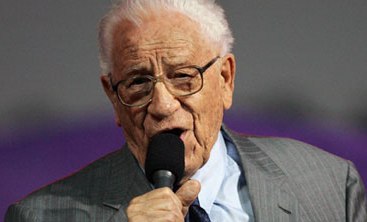The story of George Beverly Shea’s signature tune.
George Beverly Shea turns 100 on Sunday, February 1. Ever since 1944, when 26-year-old Wheaton College student Billy Graham  Not long after Diane Langberg began working as a clinical psychologist in the 1970s, a client told her that she had been a victim of sexual abuse at the hands of her father. Not sure of what to do, Langberg went to talk to her supervisor.
Not long after Diane Langberg began working as a clinical psychologist in the 1970s, a client told her that she had been a victim of sexual abuse at the hands of her father. Not sure of what to do, Langberg went to talk to her supervisor.
The supervisor, Langberg recalled, dismissed the allegations.
“He told me that women make these things up,” Langberg said. “My job was to not be taken in by them.”
The supervisor’s response left Langberg in a dilemma. Did she believe her client? Or did she trust her supervisor’s advice?
“The choice I made is pretty obvious at this point,” the 74-year old Langberg said in a recent interview.
For the last five decades, Langberg has been a leading expert in caring for survivors of abuse and trauma. When she began, few believed sexual abuse existed, let alone in the church. Churches were seen as a refuge for the weary and some of the safest places in the world.
Today, she said, there’s much more awareness of the reality of sexual abuse and of other kinds of misconduct, especially the abuse of spiritual power. Still, many congregations and church leaders have yet to reckon with the damage that has been done to abuse survivors where churches turned a blind eye to the suffering in their midst.
“We have utterly failed God,” she said. “We protected our own institutions and status more than his name or his people. What we have taught people is that the institution is what God loves, not the sheep.”
The daughter of an Air Force colonel, who grew up attending services in a variety of denominations, Langberg still has faith in God. And she remains a churchgoer, despite the failings of Christian leaders and institutions. Still, she said, those churches and institutions have a great deal to repent of and make amends for.
Langberg, author of Redeeming Power: Understanding Authority and Abuse in the Church, spoke with Religion News Service about the sex abuse crisis in the Southern Baptist Convention, what lessons she’s learned over the past five decades and why she keeps the faith despite the church’s flaws.
This interview has been edited for clarity and length.
When it comes to sexual abuse, there are a growing number of church leaders who say, “We get this now and we can fix it.” But are they aware of the long-term consequences that come with mishandling abuse allegations over a long period of time?
Perhaps it would be helpful to first think about not the church but marriage. If somebody has an affair, they cry and say they are sorry. Then a year later, they have an affair with somebody else. How many affairs are going to be OK before you leave?
That is the kind of thing that has happened regarding the Southern Baptists. This has gone on for a really, really long time. And now they want to say they get it. It’s too soon. Even if they were doing absolutely everything they could to get it. It’s too soon.
How can church leaders start to regain trust?
The first step is not asking for it. The first step is to say, “I want to know what this has done to you. I want to know the ways that it’s been hurtful, I want to really understand the depths of what we did, and how it affects you, not just in terms of church, but in terms of understanding God himself.” To realize that this person whom God loves has been damaged by us who represent God. And we can’t fix that.
We have utterly failed God. We protected our own institutions and status more than his name or his people. What we have taught people is that the institution is what God loves, not the sheep.
What have you learned in 50 years of this work?
I don’t think we really understand the level of deception that occurs in people who abuse. We think that if they cry and say they are sorry, that’s a good thing. But it doesn’t touch the practice of deception that runs their lives and that runs their organizations. We’re very naive about that. You can’t marinate yourself in the lies and deception that are needed to keep abusing—and then say “I’m sorry” and have that change who you are.
There’s been a growing awareness about the dangers of the abuse of children and a willingness to address that issue on the part of churches. But many churches have a difficult time with the idea that adults can be abused. There’s an idea that if you are an adult, then a pastor can’t abuse you.
I find that outrageous, to put it mildly. The word “abuse” means to use wrong. I don’t think we understand the power that comes with the position of being a pastor. I mean, do we really think pastors can’t abuse that power? That they’re above this?
That’s a ridiculous thought about any human being. We’re all sinners. We’re all deceptive. We all deceive. To say just because somebody is a pastor means they can’t be abusive is naive.
If you had a group of Southern Baptist leaders right now in front of you, what would you tell them?
I would tell them that the first thing they need to find is humility. You can’t do something wrong for decades and then say, “Oh, we’re sorry, we did it wrong”—and think that now you understand it. It’s not possible for any human. You can’t cry and say you are sorry and ask for forgiveness and then it’s all fixed. My reading of the Scriptures and how sin gets ahold of us, and blindness gets ahold of us, would suggest that’s way off the mark.
What have you learned from survivors of abuse?
We don’t realize the level of courage that has been displayed right in front of us. Particularly in Christendom, if you tell the story of surviving abuse, you’re not only going against the person who did it, you’re going against God’s people, you’re going against his church, which adds up to going against God.
And survivors often lose their place in the church. They lose any status they had. They lose honor. They lose trust. All because of the things that were done to them.
Have you ever thought of giving up?
I cut my teeth working with Vietnam vets and with women who told me about abuse that nobody believed. The diagnosis of post-traumatic stress disorder hadn’t come out yet. So people thought vets were making it up because they were weak, and the women were making it up because they wanted attention. It was a very lonely road. And somewhere along the way, I told God I was quitting. He obviously convinced me not to do that. Then when I began to realize how much of this was in the church, I wanted to walk away. He convinced me to stay. And I’m very glad I did.
The song most associated with Billy Graham is “Just As I Am,” but Bev Shea’s signature tune is clearly “How Great Thou Art.” Even though nearly every gospel artist – from Elvis Presley to the Mormon Tabernacle Choir – has recorded it, it is Bev Shea’s tune. Here’s the story of that song.
George Beverly Shea’s first contact with “How Great Thou Art” dates to 1954. But the song itself dates to 1885, when Swedish pastor Carl Gustav Boberg was caught in a thunderstorm.
It was a thunderstorm that, according to legend, struck fear into the heart of Martin Luther and extracted from him a vow to become a monk. Pastor Boberg, on the other hand, was filled with awe at the grandeur of the storm, the rainbow, and the brilliant light and bird songs that followed the storm.
Boberg sensed the power of God in that storm much the way the writer of Psalm 29 did: “The God of glory thunders, the LORD thunders over the mighty waters. … The voice of the LORD strikes with flashes of lightning.” The storm’s majesty inspired Boberg (who later became editor of the Christian newspaper, Witness of the Truth, and a member of the Swedish parliament) to write a nine-stanza poem along the same lines. “I see the stars, I hear the mighty thunder, / Thy power throughout the universe displayed.”
Boberg published the poem in 1886, then sold the rights to the Mission Covenant Church in Sweden. Two years later he visited a church in Varmland and was surprised to hear the congregation singing his words to an old Swedish folk tune. In 1891, Boberg published the poem again, this time with the tune in Witness of the Truth.
From Sweden to Nagaland
The hymn made its way to the English speaking world circuitously – via a German translation (Wie gross bist Du, 1907) and from German into Russian (1912). In 1922, that Russian version was published in America as part of a collection of Russian language hymns by the American Bible Society. The hymn reached American shores again in 1925, thanks to a Swede named E. Gustav Johnson who translated several verses of the Swedish original into English. At that time, however, the song just didn’t catch on with American worshipers.
It was the Russian version that caught the attention of English missionary Stuart K. Hine who with his wife was evangelizing the Ukrainian countryside. Hine used the Russian hymn in his ministry there and developed an English version as well. The first two verses of Hine’s English mirrored Boberg’s awe at God’s power in nature. To these he added a third verse devoted to the amazing love of God expressed in Christ’s atoning death: “And when I think that God, His Son not sparing, / Sent him to die, I scarce can take it in.”
The outbreak of World War II forced the Hines back to London, where they continued to evangelize among war refugees frightened by the German blitz. The promise of deliverance at Christ’s Second Coming inspired Hine to add a fourth and final verse: “When Christ shall come with shouts of acclamation …”
In 1949, Hine published the hymn in a missionary magazine that went out to 15 countries. The song spread and reached America again in 1951when it was introduced by James Caldwell at the Stony Brook Bible Conference Center on Long Island. And in 1954, the future Fuller Seminary missiologist J. Edwin Orr heard it sung by Naga tribespeople in India.
The Graham Team
That was the same year that George Beverly Shea bumped into his friend George Gray on Oxford Street in London. Gray gave him a copy of “How Great Thou Art” that he just happened to have in his briefcase. In this 1982 video produced by World Wide Pictures, Shea recalls that meeting and the way the song began to play a role in Billy Graham crusades. (The segment dealing with “How Great Thou Art” begins 16 minutes and 23 seconds into the 20-minute video.)
Song leader Cliff Barrows had also been given a copy of the song, and after the 1954 London Harringay crusade, Barrows had Paul Mickelson arrange the music for use in the 1955 Toronto crusade in Maple Leaf Garden. However it was not until Billy Graham’s 1957 Madison Square Garden crusade that the song became extremely popular. “We sang it about a hundred times at the insistence of the New York audiences,” says Shea. “And from then on, it became a standard at most of the crusades.”
That sounds like the end of the story. But history is full of ironies and strange twists. This surely is one: Although Boberg’s “O Store Gud” was sung in Sweden since the 19th century, it never became really popular there until, as Swedish gospel singer Per-Erik Hallin notes, Elvis Presley recorded a Grammy-winning version of “How Great Thou Art.” Then, thanks to Elvis, “O Store Gud” experienced a major revival and became a favorite in its native land.







